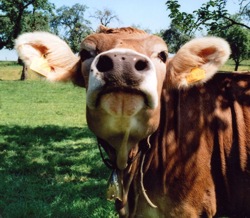
A cow fell out of the sky and crushed me flat. I pushed it aside with all my might, but then – boom! another cow came barreling out of the blue. Again, I shoved it aside, to no avail, because, hey, yet another cow was falling in its wake. After a while, I thought it would be easier to curl up beside the cow for a while and stay just as I was.
This didn’t happen, of course: as far as I know my street has not been bombarded by a plague of tumbling bovines. But in a way, it did: it accurately describes the way I felt during a bout of depression last summer. I am, happily, fully recovered: as the National Institute of Mental Health points out, most people who experience depression get better with treatment. Women, however, may be especially vulnerable: depression and other stress-related illnesses such as post-traumatic stress disorder are twice as common in women as in men.
A new study published today in the journal Molecular Psychiatry by neuroscientists at the Children’s Hospital of Philadelphia sheds some light on why this may be so: females (well, female rats, at any rate) are more sensitive to stress hormones and less able to adapt to the hormones than males. Rita Valentino, Debra Bangasser and colleagues studied corticotropin-releasing factor, a molecule released by the brain that regulates the body’s response to stress. CRF secretion has been shown to rise during periods of depression, and depression is often preceded by highly stressful events. Valentino found that brain cells of female rats were excited by doses of CRF that were too low to affect male rat brain cells. They also discovered that brain cells of male rats exposed to stress (a forced 15 minute “swim test” in a water-filled cylinder) responded to the stress by ingesting a receptor protein for CRF, reducing its effect. Female rat brain cells didn’t do this, suggesting that females are less able to adapt to high-stress conditions.
The underlying reason for the increased frequency in depression in females is not well understood, Valentino says. “By providing evidence for sex differences in the function of the receptor for a stress neurohormone, this research suggests a potential molecular mechanism that can account for the disproportionate incidence in females.” She adds: “It certainly may not be the only mechanism. It also emphasizes the importance of using female subjects in research on stress-related disorders and the development of drugs used to treat them.”
Now, à propos of cows and stress, I was pleased to read recently of a Norwegian study published in Acta Veterinaria Scandinavica showing that untied cattle in small herds produce less milk than cows tied to their stalls; however, the untethered ruminants are more fertile and suffer less indigestion and fewer teat injuries. As herds grew larger, milk yield increased.
Lead author Egil Simensen of the Norwegian School of Veterinary Science, Oslo, says that cattle are social animals and readily form dominance hierarchies, especially at areas of access to feed, water and rest. It may be, he says, “that cattle which are free to move around spend more time fighting and less time feeding in small free-stalls.” Or more time plummeting out of the blue, perhaps.
Image courtesy of Volker Steger